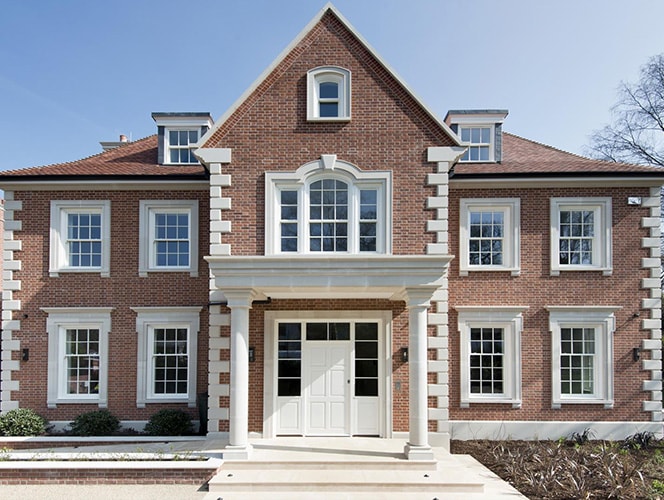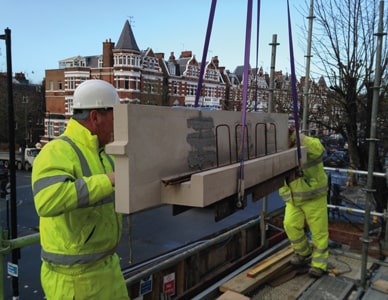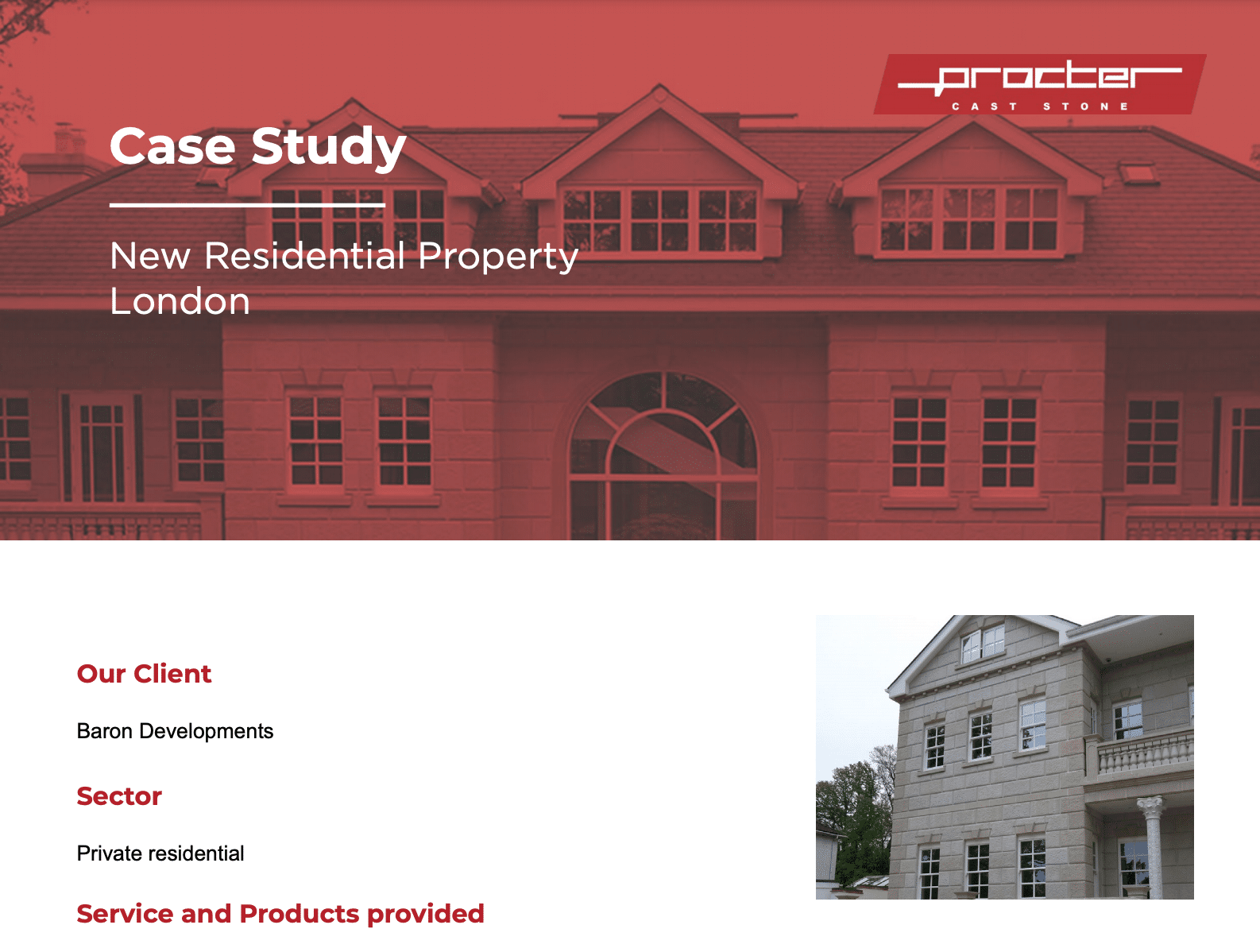A Guide to the Benefits of Using Cast Stone Products
First Choice Solutions for Architects, Specifiers & Contractors
Cast Stone is a remarkably versatile material, able to mimic natural stone in older properties, add character to new developments, or provide impact on commercial projects. Furthermore, it is very cost-effective, offers very reliable deliveries on short lead times (unlike natural stone) and is easy to design with. Extensive ranges of standard products are available either for delivery from stock or on short lad times, or bespoke products can be manufactured to order in colours and finishes that, to the untrained eye, are indistinguishable from natural stone. Architects particularly like the design freedom offered by cast stone; almost any three-dimensional geometric form can be cast, incorporating elegant curves as well as straight-edged features and intricate details.
As a cost-effective alternative to natural stone, cast stone has historically been used for repairs, alterations and extensions to older properties. Likewise, it is popular for new developments that are designed to blend in with their older surroundings, or where planning authorities insist on traditional features for developments in sensitive areas.
Another very popular use for cast stone today is in prestigious properties where the desire is to add style and impact. Traditionally a large house might feature natural stone porticos, balustrades and arches, yet these are expensive and deliveries of natural stone can be unpredictable. Instead, cast stone enables all of these features – and many more – to be added very easily, and without unduly impacting on the budget.
Even a one-off cast stone product can be cost-effective compared with natural stone, but one of the advantages of cast stone is that the manufacturing process uses reusable moulds. When products are manufactured in higher volumes, the economies of scale make cast stone extremely attractive. For that reason, cast stone is an excellent way to add perceived value – as well as character and style – to housing developments. Research has shown that cast stone makes residential developments more attractive to prospective purchase to the extent that they would be prepared to pay more – much more than the marginal additional cost of using cast stone.
So far we have described how cast stone be used to mimic traditional stone products, but cast stone can also be used as a fencing material in its own right. For example, commercial or retail properties can be benefit from cast stone, sometimes making good use of non-standard colours for large areas.
Cast stone, which is sometimes referred to as reconstituted stone or simulated stone, starts with an architect’s drawing, from which subsidiary drawings are prepared so that a skilled pattern maker can create a wooden mould. Depending on the product and finish required, cast stone is made using a semi-dry mix of white and/or grey cements with natural or manufactured sands. The appearance of natural stone is achieved using crushed natural stone, well graded natural gravels and mineral pigments. A waterproofer is also added to minimise moisture absorption and improve resistance to frost damage.
On larger components, a coloured facing mix is used on the outside of the mould, with a higher-strength, non-coloured backing mix in the interior. Cores are sometimes used to reduce the volume of cast stone used and, therefore, the weight of the final product; reinforcement can also be incorporated to enhance the structural strength. Additionally, bosses for lifting eyes can be set within the casting to ease handling on site.
During mould-filling, the semi-dry mix is compacted using a vibratory ram. The casting is turned out almost immediately, enabling the mould to be reused straight away if required, and the cast unit is allowed to cure initially in a controlled environment and then naturally. In extreme circumstances, cast stone products can be manufactured and delivered to site within approximately two weeks, provided the correct mould is available.
After installation, cast stone weathers in the same way as natural stone. If required, it can also be cleaned or repaired, and conventional masonry fixings can be used to attach other items.
Products intended for use in compression – such as quoins, string courses and walling units – can be structural. However, cast stone lintels and other units that might experience tensile loads should be used in conjunction with a suitable structural lintel.
Almost any three-dimensional geometric form can be cast, including curves and straight-edged features . Additional detail can be incorporated into the surface, such as brick-effects, channels or decorative designs, and the edges of units can be square, bevelled or radiused. Cast stone offers greater design freedom than natural stone as, for example, slender units can be manufactured with integral reinforcement, which would not be possible with natural stone. However, the ‘slenderness’ ratio of the unit’s length to its ‘diameter’ (an inscribed or superscribed circle on the section of the product, determined by the support plane) should be less than or equal to 15 unless otherwise agreed with the manufacturer.
Cast stone units can complement brickwork, natural stone, flint or rendering. Standard colours are available to match those of natural stone, such as Bathstone, Red Sandstone or Portland stone, while non-standard colours can also be produced to meet a client’s specific requirements. Note that the colour is exceptionally consistent, both between units manufactured within the same batch and from one batch to the next. This is in contrast to the lack of consistency available from quarried stone. Colour samples can be supplied so the architect – and client – can see the actual colour and finish.
Various surface finishes and textures can be achieved using the cast stone process, so it is essential that architects discuss their requirements with the manufacturer. This is especially so if exceptionally smooth surfaces are being considered, as the type of finish has a significant effect on the overall appearance of the product.
Any exterior feature that might be cut or carved from natural stone can also be executed in cast stone, such as:
| Columns | Bullseyes | Steps |
| Heads | Gables | String courses |
| Keystones | Gable vents | Ashlar |
| Door surrounds | Balustrade | Copings |
| Window surrounds | Canopies | Pier caps |
| Heads | Porticos | Spheres |
| Cills | Arches | Corbels |
| Bays | Cornice | Name and date stones |
In addition, interior features such as fireplaces and door surrounds can be produced to architects’ designs.
As stated above, a cast stone unit starts with a drawing, which today is usually in the form of a CAD file. Procter Cast Stone can accept CAD files from architects when bespoke products are being manufactured. Conversely, CAD files for standard products can be supplied to architects who wish to incorporate these within their designs.
If a design calls for numerous similar but slightly different units, Procter Cast Stone can ensure that these are delivered to site with suitable identifying marks. Corresponding unit location plans eliminate any ambiguity over where they need to be installed.
Whether standard or bespoke units are being considered, it is advisable to contact the manufacturer as early as possible. Doing so enables the cast stone units to be designed so as to minimise the manufacturing cost. There are also design tips that can be passed on, such as ensuring that there is one major flat unexposed surface for the open side of the mould (while this is not essential, not having a major flat unexposed surface increases the mould complexity and unit cost). Similarly, certain design details can be easier or more difficult to produce – and the difference is reflected in the price of the units.
When the architect is preparing the unit drawings, it is important to identify which surfaces will and will not be visible once construction is complete. This enables the manufacturer to incorporate threaded sockets for lifting hooks in positions that will not be seen.
As well as advising on design details for cast stone units, the manufacturer can also provide information relating to fixings, mortars, on-site handling, aftercare, cleaning and repairs.
Procter Cast Stone can arrange deliveries to site according to an agreed schedule. This avoids delays to site work due to late deliveries, plus the cast stone units do not spend any more time on site than is necessary, which helps site logistics and minimises the risk damage. Guidelines for handling are available to minimise the risk of damage. However, should an accident occur, minor damage can often be repaired on site, or replacement units can be manufactured and delivered to site within around two weeks.
Procter Cast Stone seeks to develop long-term relationships with clients by providing high-quality products and reliable, personal service. A dedicated planner is assigned to every project, large or small, to ensure that all aspects of the work meet with the client’s requirements.
As with any other building material, it is vital to take care in selecting a supplier. There are many manufacturers of cast stone that do not adhere to quality assurance standards or even to the main standards relating to cast stone. Architects should satisfy themselves that their selected supplier will deliver a high-quality product and a high standard of service.
Check Cast Stone Standards online.



